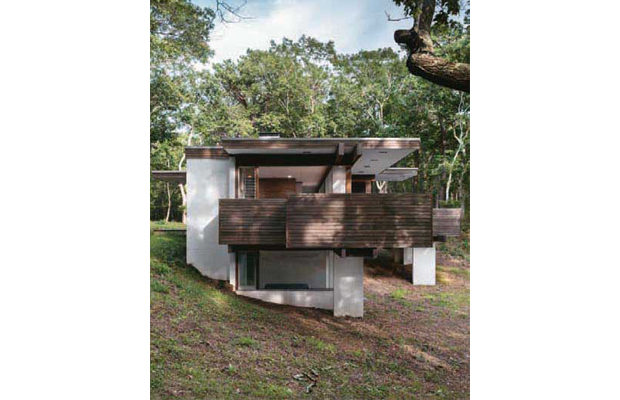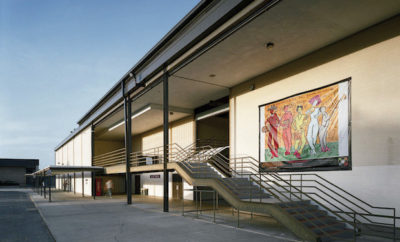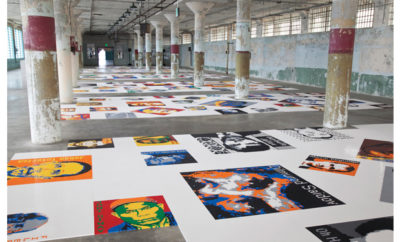 The Kugel/Gips house in Wellfleet, designed by Charles Zehnder, 1970, has been restored by the Cape Cod Modern House Trust. Courtesy of Raimund Koch photos.
The Kugel/Gips house in Wellfleet, designed by Charles Zehnder, 1970, has been restored by the Cape Cod Modern House Trust. Courtesy of Raimund Koch photos.
Architecture
Cape Cod Modern
In 1959 Massachusetts Senators John F. Kennedy and Leverett Saltonstall introduced legislation to create the Cape Cod National Seashore—a plan to preserve 44,600 acres of wild and fragile coastal land along a forty-mile stretch of the Outer Cape, a sublime and mutable terrain comprised of windswept beaches, parabolic sand dunes, salt marshes, creeks, ponds, and pine barrens. When the proposed legislation passed in 1961, President Kennedy signed it into law, and the existing buildings within the newly designated park’s boundaries fell into what architect Peter McMahon, founding director of the Cape Cod Modern House Trust, describes as “an administrative limbo.” Although the federal government acquired the land through eminent domain, the structures were leased back to their owners under a twenty-five-year agreement; at the end of the lease period, the buildings were slated for demolition and the land was to be left to nature.“The Park Service owned all these buildings, most of which were abandoned,” says McMahon who has been steadily identifying the Outer Cape’s important cache of derelict or overlooked mid-century architecture.
McMahon, principal of South Wellfleet-based PM Design, had studied in Boston and started his career in New York but always migrated back to the Outer Cape. “When I was ten, my parents hired Charlie Zehnder [one of the region’s most prolific self-taught architects] to do a summer house for us in Wellfleet,” he recalls. “Growing up in that modern house, I was fascinated by it.” In 2006 McMahon and Bob Bailey, a Truro-based artist, co-curated A Chain of Events: Modernist Architecture on the Outer Cape, Marcel Breuer to Charles Jencks for the Provincetown Art Association and Museum. As their initial exhibition concept expanded from simply photographing abandoned houses to collecting archival material, producing new architectural models, and selecting local art from the postwar period, the idea for the Cape Cod Modern House Trust evolved. Meeting with Bill Burke, historian for the park, McMahon began to pore over binders filled with blurry images of endangered structures still standing throughout the National Seashore and tracked down any place that displayed a “flat-ish roof” and a whiff of modernism. While inspecting the 1970 Kugel/Gips house—with its rotting wooden decks and weather-beaten plate glass—McMahon quickly recognized Zehnder’s architecture. “Bill told me if I had a nonprofit organization, the park could lease the building to it and I could figure out what to do with it,” McMahon says. “So I filed for a creative 501(c)(3) and that was it.”
Established in 2007 as a grassroots organization, the trust has obtained leases for three of the surviving modern houses on the federally owned seashore. Working with an extraordinary range of volunteers, donors, and support from the Community Preservation Act, a Massachusetts initiative dedicated to preserving historic sites and open spaces, restoration has been completed on the Kugel/Gips house, the Hatch house (1962), and the Weidlinger house (1953). During the spring and autumn, the houses are used to host a residency program for artists and scholars; in the summer, they are rented to appreciative modernist aficionados or traditional nature lovers and offered to trust members as a premium. “The summer rentals make a huge difference,” McMahon admits. “If we’re able to get a building on its feet, it supports itself and we don’t have to fund-raise our entire budget every year.”

Overlooking Cape Cod Bay in Wellfleet, the Hatch house, designed by Jack Hall, 1960, has been restored by the Cape Cod Modern House Trust. By Koch photos.
Since the early twentieth century, the Outer Cape has attracted unconventional holiday makers—avant-garde circles of artists, writers, and designers with a reverence for rustic living and progressive ideas. As writer Mary Heaton Vorse, a 1920s Greenwich Village radical and long-time resident of Provincetown, observed in 1942, “People here have been nourished by beauty and change and danger.” Thus came houses and studios that rested lightly on the land, constructed with a knack for improvisation: the “Paper Palace,” a nautical moderne beach house (1938), was made out of reclaimed timber and Homasote fiberboard; a chicken coop artfully repurposed as a string of sleeping huts provided inspiration for the refined modular grid of the Hatch house; and Bernard Rudofsky, the influential architect and social critic, summered in a primitive cabin, a remnant from a defunct Girl Scout camp. Beginning in the late 1930s an extraordinary wave of European émigré architects and designers—including Marcel Breuer, Serge Chermayeff, and Olav Hammarström—settled in the area; the homes they made for themselves provided an idyllic escape, laboratories for testing design prototypes, and a social roundelay of cocktail parties and invigorating conversation.

Hatch house porch by Koch photos.
In addition to restoring endangered houses, the Cape Cod Modern House Trust has identified and archived information about nearly one hundred local “modern houses of interest.” In July Metropolis Books will publish Cape Cod Modern: Midcentury Architecture and Community on the Outer Cape, a vibrant cultural history that considers how time, place, and intersecting lives coalesced to generate the built environment. Co-authored by McMahon and Christine Cipriani, a Boston-based writer and Wellfleet summer resident, the pages of Cape Cod Modern brim with captivating images, original scholarship, unexpected legacies, and humorous anecdotes. Central to the trust’s mission, the authors state in their introduction, “is the notion that buildings and landscapes bear cultural memories.” In Cape Cod Modern, those cultural memories have been preserved with great dedication and joy.












